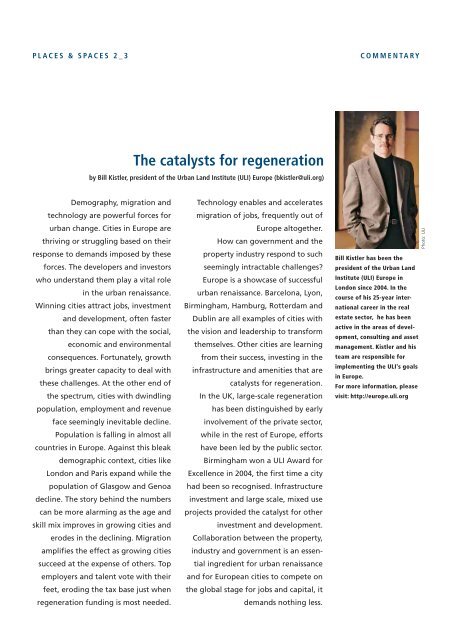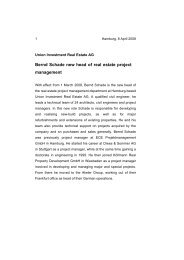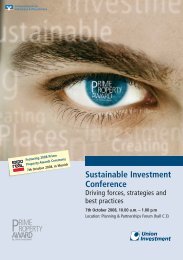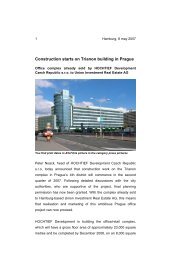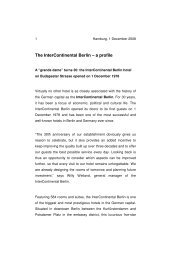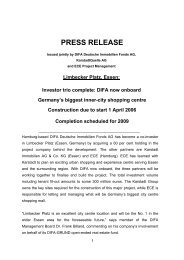BREAKTHROUGH IN THE CITY Why London's ... - Union Investment
BREAKTHROUGH IN THE CITY Why London's ... - Union Investment
BREAKTHROUGH IN THE CITY Why London's ... - Union Investment
Create successful ePaper yourself
Turn your PDF publications into a flip-book with our unique Google optimized e-Paper software.
PLACES & SPACES 2_3 COMMENTARY<br />
Demography, migration and<br />
technology are powerful forces for<br />
urban change. Cities in Europe are<br />
thriving or struggling based on their<br />
response to demands imposed by these<br />
forces. The developers and investors<br />
who understand them play a vital role<br />
in the urban renaissance.<br />
Winning cities attract jobs, investment<br />
and development, often faster<br />
than they can cope with the social,<br />
economic and environmental<br />
consequences. Fortunately, growth<br />
brings greater capacity to deal with<br />
these challenges. At the other end of<br />
the spectrum, cities with dwindling<br />
population, employment and revenue<br />
face seemingly inevitable decline.<br />
Population is falling in almost all<br />
countries in Europe. Against this bleak<br />
demographic context, cities like<br />
London and Paris expand while the<br />
population of Glasgow and Genoa<br />
decline. The story behind the numbers<br />
can be more alarming as the age and<br />
skill mix improves in growing cities and<br />
erodes in the declining. Migration<br />
amplifies the effect as growing cities<br />
succeed at the expense of others. Top<br />
employers and talent vote with their<br />
feet, eroding the tax base just when<br />
regeneration funding is most needed.<br />
The catalysts for regeneration<br />
by Bill Kistler, president of the Urban Land Institute (ULI) Europe (bkistler@uli.org)<br />
Technology enables and accelerates<br />
migration of jobs, frequently out of<br />
Europe altogether.<br />
How can government and the<br />
property industry respond to such<br />
seemingly intractable challenges?<br />
Europe is a showcase of successful<br />
urban renaissance. Barcelona, Lyon,<br />
Birmingham, Hamburg, Rotterdam and<br />
Dublin are all examples of cities with<br />
the vision and leadership to transform<br />
themselves. Other cities are learning<br />
from their success, investing in the<br />
infrastructure and amenities that are<br />
catalysts for regeneration.<br />
In the UK, large-scale regeneration<br />
has been distinguished by early<br />
involvement of the private sector,<br />
while in the rest of Europe, efforts<br />
have been led by the public sector.<br />
Birmingham won a ULI Award for<br />
Excellence in 2004, the first time a city<br />
had been so recognised. Infrastructure<br />
investment and large scale, mixed use<br />
projects provided the catalyst for other<br />
investment and development.<br />
Collaboration between the property,<br />
industry and government is an essential<br />
ingredient for urban renaissance<br />
and for European cities to compete on<br />
the global stage for jobs and capital, it<br />
demands nothing less.<br />
Bill Kistler has been the<br />
president of the Urban Land<br />
Institute (ULI) Europe in<br />
London since 2004. In the<br />
course of his 25-year international<br />
career in the real<br />
estate sector, he has been<br />
active in the areas of development,<br />
consulting and asset<br />
management. Kistler and his<br />
team are responsible for<br />
implementing the ULI's goals<br />
in Europe.<br />
For more information, please<br />
visit: http://europe.uli.org<br />
Photo: ULI


